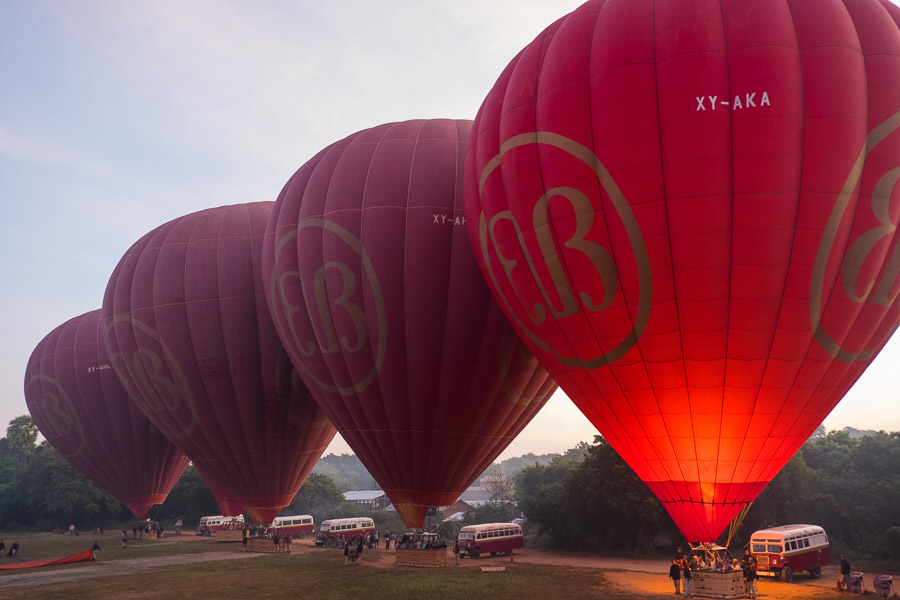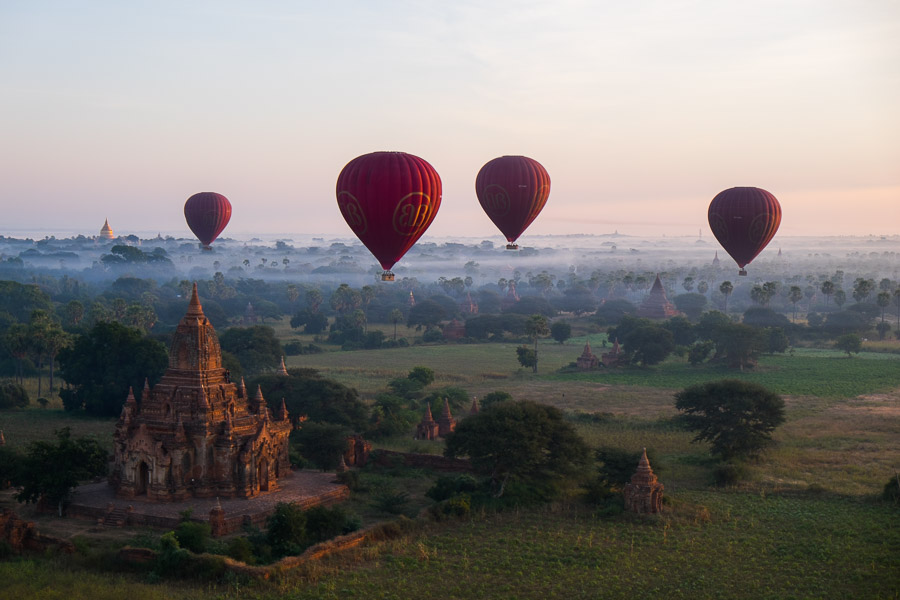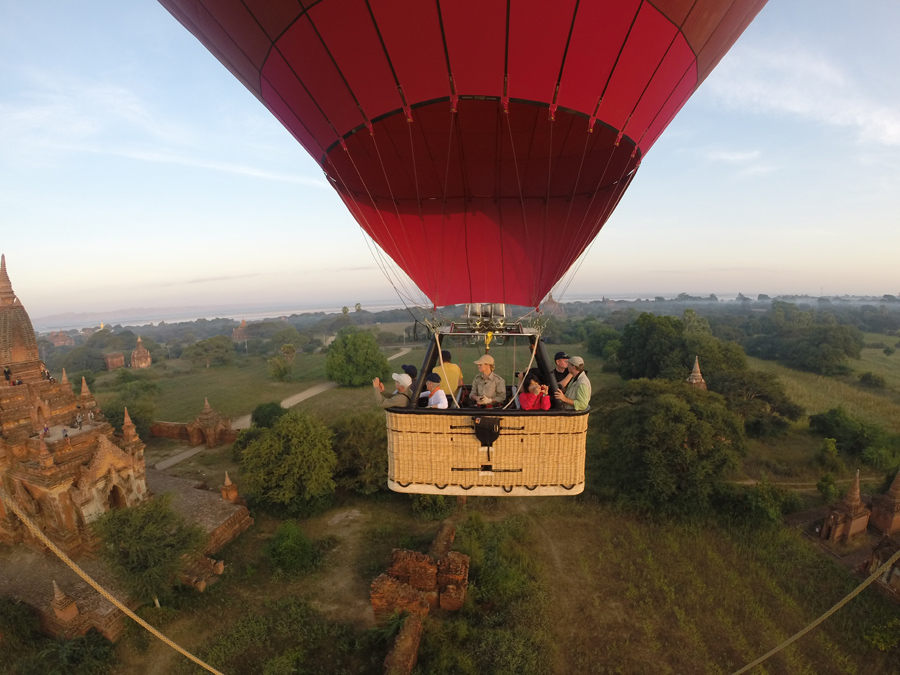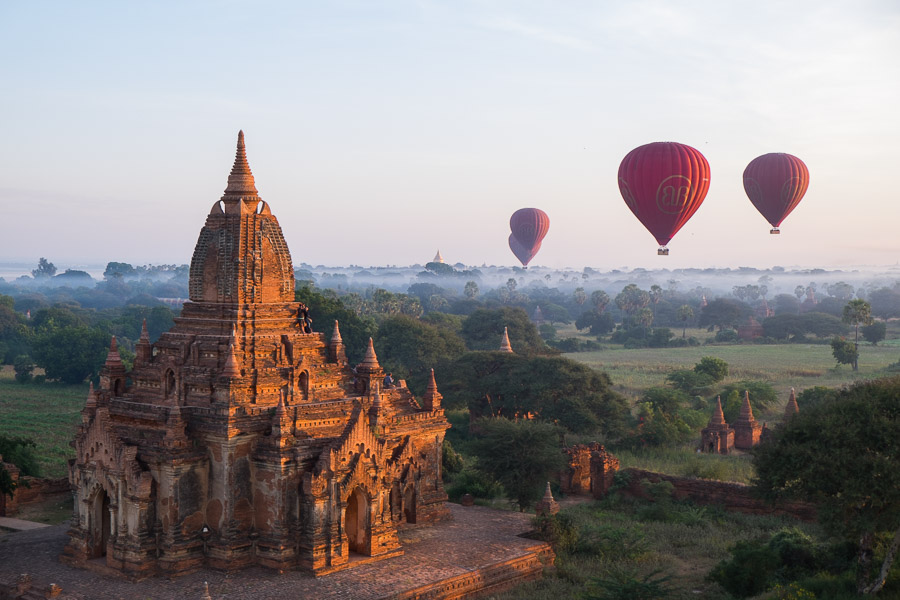Hot air ballooning in Bagan, Myanmar
Riding a hot air balloon over the temples in Bagan last year was one of the best things I’ve ever done.
There are now several hot air ballooning companies in Myanmar – we flew with Balloons over Bagan (BOB), privately owned and the first commercial hot air balloon operation in South East Asia. BOB started with just a single balloon back in 1999 and now has 10 balloons. The company employs 16 foreign pilots and technicians and has over 100 local staff. Their flights only take place when there are light winds less than 8 knots, and they have had no accidents to date.
A 1944 Chevrolet World War II vintage bus picked us up from our hotel before dawn and took us to the launch field where tea/coffee and biscuits were waiting. Hot tip: your ballooning excursion doesn’t include toilets, so go easy on the liquids. We watched the balloons inflate from sausage skins on the ground into enormous, bulbous onions. Ours was the first balloon of the day’s red fleet to take off.
Yes, I secretly had a few last-minute nerves but felt reassured when I met our pilot, an Australian named Elly, who had flown more than 1,700 hours. Her hubby’s a BOB balloon pilot too, and before coming to Bagan, they were balloon safari pilots over the Maasai Mara game reserve in Kenya. Before we left the ground, we ran through the safety procedures and practiced the ‘landing position’.
Our group was booked in for the Premium Service – 8 passengers plus pilot. The Classic Service costs less and includes double the number of passengers. For serious photographers, it’s much easier to take pictures with fewer people sharing the basket. Tripods are not allowed but I had no problem taking my two cameras onboard – 18-55mm lens on one, 55-200mm on the other (my two longest lenses).
It’s strangely quiet, gently floating in a balloon, apart from the occasional blast of the burners overhead. The basket felt very stable in flight and didn’t sway at all. It does get hot standing below the roaring flame but it’s not unbearable and isn’t constant (wearing a cap helps). You must sit for the landing but you’re free to stand and move within your section of the basket during the flight. People waved at us from below – local kids playing in the fields, ladies selling pottery at a market stall, sunrise-seeking tourists perched on the red brick temples. The views were spectacular, the experience a breathtaking, surreal and exhilarating dream.
Elly turned the balloon on its vertical axis throughout the flight, so there was no good or bad side of the basket. She was in radio contact with other BOB pilots the entire time. The direction and duration of balloon flights is dependent on the wind and weather conditions – our flight lasted around an hour.
I couldn’t help feeling a little sad as we slowly made our descent towards earth. Elly made sure we were all safely seated in landing position (with no cameras hanging from our necks) before we touched down with a soft bump in a field. Waiting crew members held the basket steady and helped us climb out when Elly gave the OK. Our amazing adventure ended with champagne and croissants, fresh fruit and sticky banana cake.








 Other hot air ballooning companies had flights that morning too.
Other hot air ballooning companies had flights that morning too. 











 We could see the balloon crews making their way to the fields where we would be landing.
We could see the balloon crews making their way to the fields where we would be landing.  Getting out of the basket was even trickier than getting in, but these guys were happy to help and much too polite to laugh at my lack of coordination.
Getting out of the basket was even trickier than getting in, but these guys were happy to help and much too polite to laugh at my lack of coordination.  Every balloon has a GoPro attached (on the left, in the picture above) so the pilot can take photos throughout the flight. You can see here that the passengers are all safely seated for the landing.
Every balloon has a GoPro attached (on the left, in the picture above) so the pilot can take photos throughout the flight. You can see here that the passengers are all safely seated for the landing. 

 Our pilot Elly telling more stories after the flight.
Our pilot Elly telling more stories after the flight. The view through the back window of the bus on our ride back to the hotel.
The view through the back window of the bus on our ride back to the hotel. 
Finally, a photo taken by our pilot Elly via our balloon’s GoPro. Unfortunately, I was on the side furthest away from the camera, and being short, a little hard to see – in the photo, I’m to the right of Elly, behind the woman in the red jacket – you may just be able to see my zoom lens pointed at the temple to the left.

- Flights are available October to March.
- If you’re keen to do this, book early. Places fill up way in advance.
- Current prices: Classic Service Flight US$320-330 per person (16 passengers); Premium Service Flight US$380-390 per person (8 passengers).
Check the BOB website for dates and more details. We got a group discount for our booking and paid US$330 per person last year for our Premium flight. - All flights include transfers to/from hotel, coffee/tea and biscuits before the flight, champagne and light snacks after.
- We were picked up early (around 6am from memory) and dropped back at our hotel by around 9am.
- Our Premium Service included a USB drive of photos from the flight for each person, delivered to our hotel around lunch time (if you book the Classic Service, a USB drive of photos from your flight will cost an extra US$15). We each also received a BOB cap and certificate signed by our pilot.
Myanmar series
I went on a photography tour in Myanmar last year, 4 to 16 December.
- Yangon
- Hot air ballooning in Bagan – this post
- Nunnery at Sagaing Hill
- Scenes from Zay Cho Market, Mandalay
- Inle Lake
Photography tour
- I flew to Myanmar via Singapore Airlines (Perth to Singapore) and then Silk Air (Singapore to Yangon).
- The tour was with Cardinal Photo, led by our photographer guides David Cardinal and Ed Reinke. They’ve been coming to Myanmar for around 10 years and are very knowledgeable. We visited/stayed in Yangon, Bagan, Mandalay, Pindaya and Inle Lake.
- The tour cost was US$7,695 (including $300 earlybird discount) which included all transfers within Myanmar (we travelled in a private air-conditioned bus and via domestic flights), all meals (including local beer and wine), bottled water* while out in the field, our local guide and all park/temple entrance fees. I paid an additional $330 to go hot-air ballooning in Bagan and an extra $1800 single supplement (to have my own room; the base price is for double occupancy). Yes, I could’ve gone to Myanmar for a lot less, but the tour had all the logistics organised with photography as the priority, and took us to places I probably would not have accessed on my own. For me, it was well worth the expense.
- Cardinal Photo organised this trip with local tour company Tour Mandalay. Our local guide Aung was excellent – there’ll more from him later in the series.
- David was great with answering my various queries via email before I took the plunge and paid my deposit, as well as in the lead-up to the trip.
- Info on this year’s upcoming tour is online: Myanmar Photo Tour December 2015
*Tap water isn’t safe to drink in Myanmar. Tour Mandalay kept us well supplied with bottled water every day and we got complimentary bottled water at most of the places we stayed. I didn’t just drink the bottled water, I brushed my teeth with it too.
Getting a visa for Myanmar
I had two options for getting a tourist visa:
- The Myanmar Embassy in Canberra (which would require mailing my passport to Canberra) – cost AU$35.
- eVisa online via the official Myanmar Government eVisa website – cost US$50. This is a relatively new option that has only been available since 2014.
As I wasn’t keen to post my passport to Canberra, I chose eVisa. Once approved, I received an Entry Visa Approval Letter, which I had to print out and take with me to show at the eVisa desk upon arrival at the Yangon International Airport (once verified, they stamped my passport). It was quick and easy.
The eVisa approval letter is valid for 90 days from the issued date. I didn’t want to leave it too late in case there was a problem/delay, so I applied on 20 October. I received the approval letter via email (a PDF attachment) a week later. My visa approval was valid from 27 October 2014 to 25 January 2015 (no problem, as I was in Myanmar from 4-16 December).
Money in Myanmar
- Cash is the best way to go. There are ATMs in the major cities but I didn’t pay much attention to them as I had no intention of using ATMs on this trip.
- The local currency is kyat. US dollars are widely accepted. I had both. When buying souvenirs (pretty much all I spent money on, as everything else was covered in the tour cost) I paid with US dollars and with kyat at different places.
- US$1 equals approximately 1200 kyat (as with any currency conversion, this will vary).
- I changed some US dollars to kyat at the airport (and then from kyat back to USD on my departure). Your US dollar bills must be clean, and without marks or creases, preferably new – or they may be rejected. I’ve read that some money changers won’t accept US bills made before 2006. You’ll get a better rate when changing $100 bills (compared to $50 or $20 bills).
Internet access in Myanmar
Not everyone will care about internet access when they travel, but it’s important to me, so here are my notes:
- All of our hotels had free wifi, though the Pindaya Inle Inn’s wifi didn’t work at all.
- I also bought a Telenor sim card (I was impressed they had nano sim cards) at Yangon International Airport for 1500 kyat and paid an additional 10,000 kyat for 1GB data. The supplied instructions took me a few attempts to decipher! Telenor is reasonably new to Myanmar and as I expected, my Telenor signal was best i.e. worked, but slowly – in Yangon and Mandalay, and was non-existent in the other places we visited. A couple of others in our group got sim cards from Ooredoo, another newish mobile provider, and experienced similar issues. In retrospect, it wasn’t really worth getting the local sim – I wrote it off as a cheap failed experiment.
- Hotel wifi was generally slow but I was able to update social media and send Jac emails every day (apart from our 1 night in Pindaya).
